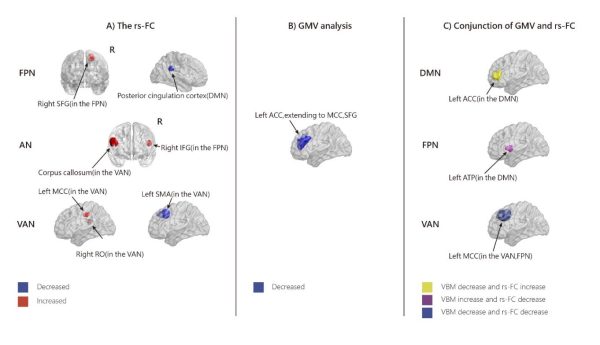News Express: UM achieves significant advances in research on behavioural addiction and decision making
新聞快訊:澳大在行為成癮與神經決策研究取得重要進展

行為成癮者的大腦功能網絡改變(A)、大腦結構改變(B)以及大腦功能改變和結構改變的重組(C)
(a) Changes in brain functional network; (b) changes in brain structure; (c) conjunction of changes in brain functional network and structure of individuals with behavioural addiction
澳大在行為成癮與神經決策研究取得重要進展
澳門大學認知與腦科學研究中心教授袁振的研究團隊在行為成癮與神經決策(addiction and decision making)研究領域取得一系列進展,可以更準確地診斷和治療行為成癮,並為預防和干預措施提供科學依據。成果獲多部國際著名期刊刊登,引起學術界的廣泛關注。
行為成癮是一種複雜的心理和生理現象,表現為對某種行為無法控制的強迫性重複行為,包括賭博和遊戲成癮等,對個體的生活造成負面影響。行為成癮問題的日益嚴重給社會帶來了巨大的挑戰。然而,行為成癮的戒斷和治療仍然面臨許多困難,導致復發情況比較常見。因此,深入了解行為成癮的相關神經機制,例如大腦結構和功能網絡的改變,對行為成癮的診斷和治療提供了新的視角。
團隊的研究結果顯示,行為成癮個體在大尺度腦網絡中表現出明顯的異常。在功能連接性方面,團隊觀察到成癮個體在抑制控制、獎賞、自我參照等網絡中存在異常連接,這些異常連接可能導致對抑制、顯著歸因和獎勵驅動行為的受損反應。在結構方面,研究團隊發現行為成癮個體的前顱葉皮質、中顱葉皮質和額葉迴灰質體積減少,這些結構改變與行為成癮相關的認知和情緒調節有關。研究目前已被著名期刊Journal of Behavioral Addictions接收。
除了成癮研究,團隊還對神經決策過程進行深入探索。研究決策行為,不僅可以發現個體的決策特徵,還能發現患有某些疾病的患者在決策方面的潛在認知改變和大腦干預靶點。當中,慢性疼痛患者在相關方面面臨挑戰,可能表現為更冒險的決策行為。團隊發現患者群體的PFC活動異常可能是他們決策更冒險的原因之一。該研究已發表於著名神經光子學期刊Neurophotonics。
另外,研究團隊還在人類—獼猴跨物種神經決策腦圖譜繪製工作上取得重要進展。研究團隊使用兩個種群的核磁影像數據,基於連接模式在物種內腦區間的差異性和兩個物種同源腦區間的相似性,實現了宏觀層面上人類—獼猴大腦亞區的級連劃分。團隊目前基於結構和功能核磁影像模態連接數據,共設計出兩種跨物種腦圖譜繪製方案,並在成癮和神經決策的部分主導腦區、黑質和紋狀體,進行了可靠的分區演示。研究團隊從多方面證明了這些分區的可靠性,並指出基於這些新繪製的同源亞區,而非其傳統繪製,研究者將可以實現多物種層面上成癮、決策制定等相關課題研究的可靠定位和後續開展。相關研究已發表於國際著名學術期刊Cerebral Cortex和Human Brain Mapping。
行為成癮和神經決策研究均由袁振主導,澳大認知與腦科學研究中心、健康科學學院博士生曾星霖為第一作者。行為成癮課題由澳門特別行政區科學技術發展基金(檔案編號:0048/2021/AGJ和0020/2019/AMJ)、澳門教育基金(檔案編號:CP-UMAC-2020-01)和澳門大學(檔案編號:MYRG2020-00067-FHS和MYRG2019-00082-FHS)聯合資助。神經決策課題由澳門特別行政區科學技術發展基金(檔案編號:0048/2021/AGJ和0020/2019/AMJ)、澳門教育基金(檔案編號:CP-UMAC-2020-01)和澳門大學(檔案編號:MYRG2020-00067-FHS和MYRG2019-00082-FHS)聯合資助。全文可瀏覽:https://www.spiedigitallibrary.org/journals/neurophotonics/volume-10/issue-02/020901/Behavioral-modeling-and-neuroimaging-of-impaired-risky-decision-making-in/10.1117/1.NPh.10.2.020901.full?SSO=1
人類—獼猴跨物種神經決策腦圖譜繪製研究亦由袁振主導,認知與腦科學研究中心夏瀟鸞博士為第一作者。課題由澳門特別行政區科學技術發展基金(檔案編號:0048/2021/AGJ和0020/2019/AMJ)、澳門教育基金(檔案編號:CP-UMAC-2020-01)和澳門大學(檔案編號:MYRG2020-00067-FHS和MYRG2019-00082-FHS)聯合資助。全文可瀏覽:
https://academic.oup.com/cercor/article/33/12/7518/7078823和https://onlinelibrary.wiley.com/doi/10.1002/hbm.26402
欲瀏覽官網版可登入以下連結:
https://www.um.edu.mo/zh-hant/news-and-press-releases/campus-news/detail/56013/
UM achieves significant advances in research on behavioural addiction and decision making
A research team led by Yuan Zhen, professor at the Centre for Cognitive and Brain Sciences of the University of Macau (UM), has achieved significant advances in the research on behavioural addiction and decision making. They have developed methods to more accurately diagnose and treat behavioural addiction, and provided a scientific basis for the relevant prevention and intervention measures. The research results have been published in several internationally renowned journals and the findings have received notable attention in the field.
Behavioural addiction is a complex psychological and physiological phenomenon characterised by uncontrollable and compulsive repetitive behaviours, such as problem gambling and video game addiction, which have a negative impact on an individual’s daily life. The growing problem of behavioural addiction also represents an enormous challenge for society. However, the cessation and treatment of behavioural addiction still face numerous obstacles, such as the high relapse rate. Therefore, gaining a deeper understanding of the cognitive neural mechanism associated with behavioural addiction, such as changes in brain structure and functional networks, paves a new avenue for the diagnosis and treatment of behavioural addiction.
The study discovered that individuals with behavioural addictions have significant abnormalities in large-scale brain networks. In terms of functional connectivity, the research team identified abnormal connections in networks related to inhibitory control, reward, and self-referential processes. These abnormal connections might contribute to impaired responses to inhibition, significant attribution, and reward-driven behaviours. In terms of brain structure, the team found that individuals with behavioural addiction have reduced volumes of the prefrontal cortex, anterior cingulate cortex, and grey matter of the frontal gyrus, and that these structural changes are associated with addiction-related cognitive and emotional regulation. The research results have been published in the renowned journal Journal of Behavioral Addictions.
In addition to behavioural addiction, the research team also explored in depth the cognitive process of decision making. The study of decision-making behaviour can not only reveal individual characteristics of decision making but can also identify potential cognitive changes and brain intervention targets in patients with certain diseases. In particular, the study discovered that patients with chronic pain might exhibit more risk-taking behaviour. The abnormal prefrontal cortex (PFC) activity in patient groups might contribute to their inclination towards riskier decisions. The research results have been published in the renowned journal Neurophotonics.
Furthermore, the research team has made significant progress in mapping the cross-species connectome atlas of human and macaque striatum. Using magnetic resonance imaging (MRI) data from both species, they detected connectivity patterns that can achieve parcellation of striatal subregions of human and macaque at a macroscopic level based on intraspecies differences in brain regions and the similarities between homologous brain regions across species. The research team designed two cross-species connectome atlas based on structural and functional MRI modalities, and performed reliable partitioning analysis of key brain regions involved in addiction and decision making, such as the substantia nigra and striatum. The research team demonstrated the reliability of these partitions from multiple perspectives and pointed out that with these newly defined homologous striatal subregions rather than the traditional mapping methods, researchers can enable reliable localisation and subsequent investigations of addiction, decision making, and related topics at a multi-species level. The research results have been published in the internationally renowned journals Cerebral Cortex and Human Brain Mapping.
The research on behavioural addiction and decision making was led by Prof Yuan. Zeng Xinglin, PhD candidate at the Centre for Cognitive and Brain Sciences and the Faculty of Health Sciences of UM, was the first author. The two studies were both supported by the Science and Technology Development Fund of the Macao SAR (File no: 0048/2021/AGJ and 0020/2019/AMJ), the Education Fund of the Macao SAR (File no: CP-UMAC-2020-01), and the University of Macau (File no: MYRG2020-00067-FHS and MYRG2019-00082-FHS). The full version of the paper on decision making can be viewed at https://www.spiedigitallibrary.org/journals/neurophotonics/volume-10/issue-02/020901/Behavioral-modeling-and-neuroimaging-of-impaired-risky-decision-making-in/10.1117/1.NPh.10.2.020901.full?SSO=1.
The research on mapping the cross-species connectome atlas of human and macaque striatum was also led by Prof Yuan. Xia Xiaoluan, postdoctoral fellow at the Centre for Cognitive and Brain Sciences, was the first author. The study was supported by the Science and Technology Development Fund of the Macao SAR (File no: 0048/2021/AGJ and 0020/2019/AMJ), the Education Fund of the Macao SAR (File no: CP-UMAC-2020-01), and the University of Macau (File no: MYRG2020-00067-FHS and MYRG2019-00082-FHS). The full version of the paper can be viewed at
https://academic.oup.com/cercor/article/33/12/7518/7078823 and https://onlinelibrary.wiley.com/doi/10.1002/hbm.26402.
To read the news on UM’s official website, please visit the following link:
https://www.um.edu.mo/news-and-press-releases/campus-news/detail/56013/